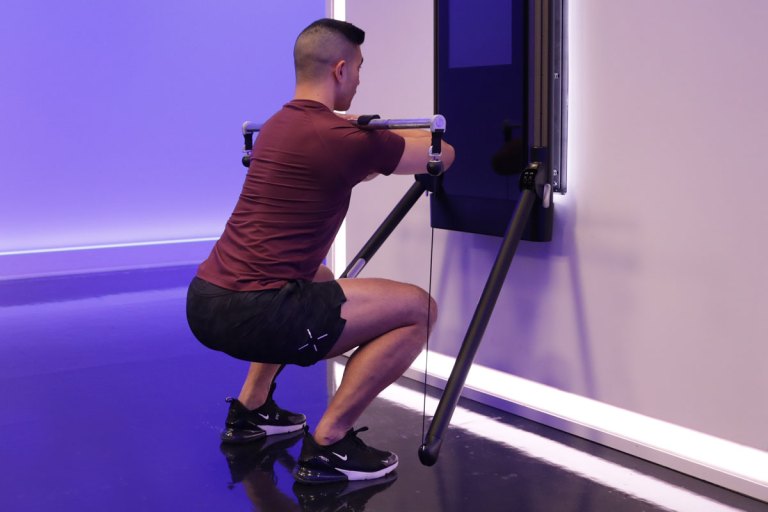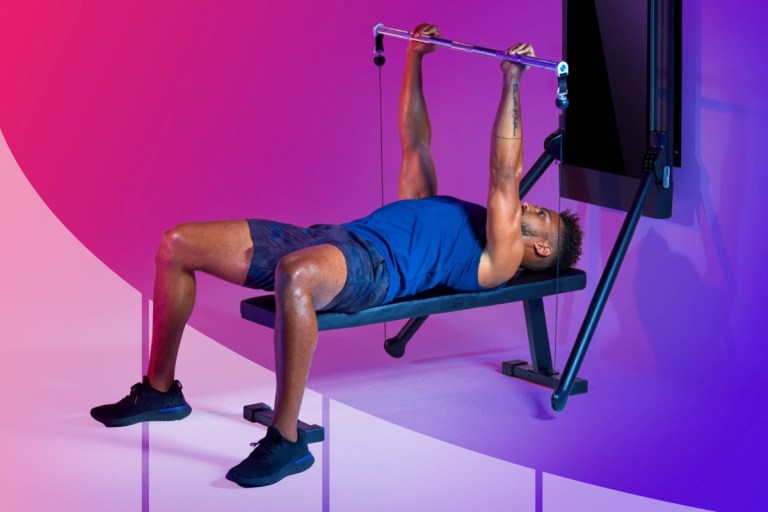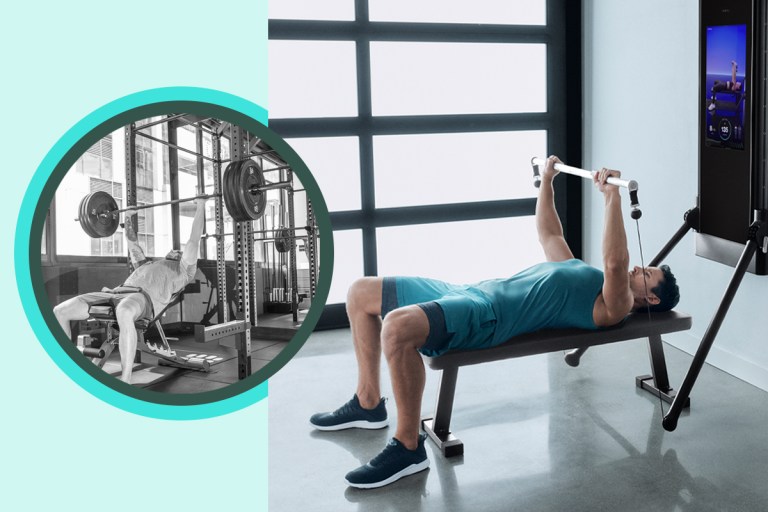Is Your Grip Strength Limiting Your Strength Gains?
Why your grip strength matters and how you can improve it.

The weight you can lift in any exercise isn’t just determined by the muscles you’re training—it’s also dependent on your grip strength. If you’ve ever felt your hands and forearms give out before your glutes and hamstrings in a deadlift , you likely have room to improve your grip.
“You’re only as strong as your weakest link,” says John Christie, CSCS, RD, and Tonal Director of Curriculum. “You may have great strength potential in your lower body to train heavier, but if you’re limited by your ability to hold the bar, then improving your grip strength unlocks access to deadlifting at higher intensities.”
Your grip plays a role in other heavy lifts, too, as well as lots of everyday activities. Here’s why a strong grip is essential to getting the most out of your training, and how you can improve your grip with grip strength exercises.
What is Grip Strength?
Grip strength refers to both the force you can generate by squeezing your fist as well as your ability to grasp and hold onto an object for time. Your grip-strength endurance, or how long you’re able to hold that heavy object, is often most important in strength training when you need to grip a bar or dumbbell for the duration of a high-volume set.
Flexor muscles in your hand, wrist, and forearm work together to contribute to your grip strength. Because these muscles are much smaller than your glutes, hamstrings, or lats, Christie says grip is likely to be a limiting factor in moves such as deadlifts, pulldowns, and heavy rows.

You can measure the strength of your grip with a hand-held dynamometer (typically used by physical or occupational therapists), but for practical purposes, Christie recommends tracking your relative grip strength using the same exercise over time to see improvements. For example, try a move that tests your grip such as a farmer march or shoulder shrug. Take note of how much resistance you’re able to hold in this exercise and how long you can comfortably hold it. As you keep practicing, you should be able to grip heavier weights for longer.
Why Does Grip Strength Matter?
Since nearly all resistance training exercises involve holding a heavy object for a period of time, a strong grip is essential if you want to make progress in your lifts. “If you can’t create enough strength to pull the implement you’re working with, then you can’t create enough load to get the [muscular] growth that you’re looking for,” says Luke Greenberg, a physical therapist and co-founder of Motiv NY.
Besides helping to prevent hand and forearm pain, a strong grip can also improve neuromuscular connections during your workouts, according to Greenberg. “Your brain responds to the fact that you’re touching and squeezing something by asking your body to create force,” he says. To understand what he means, Greenberg says to try this simple exercise: Make a fist with about 20 percent of your potential intensity and gradually ramp up to 50 percent and ultimately 100 percent of how hard you can grip. At first, you’ll likely feel a bit of tension in your hand and forearm, but as your grip intensifies, you’ll feel more tension in your biceps, triceps, and eventually in your shoulders, chest, and back as your body recruits more muscle fibers to support your grip.
Grip strength can also be an indicator of overall health even beyond your workouts. Grip strength was positively linked to reduced all-cause mortality risk, reduced risk of cardiovascular death, and a lower likelihood of disability in a review of over 500 studies. Additionally, greater grip strength was associated with higher cognitive function, better quality of life, a greater sense of well-being, and reduced anxiety and depression symptoms in a 2022 study of more than 40,000 adults.
As Christie notes, though, these benefits aren’t likely the result of grip strength alone, but rather the active lifestyle and resistance training that helps develop a stronger grip. “Your grip strength tends to increase as you expose yourself to heavier loads in training, or in life if you’re engaging in work or activities that are demanding on your grip,” he says.
How Can You Improve Your Grip Strength?
For pure grip strength gains, spring-loaded grip strengtheners in different weights are one option to specifically train your hands and forearms. Christie and Greenberg also suggest sticking your hand in a bucket of sand or rice and practicing opening and closing your fist against that resistance. It’s one of the grip strength exercises used by baseball pitchers, gymnasts, and other athletes who need a strong grip.
However, if you’re interested in functional grip strength as it relates to your lifting, you’re better off multi-tasking and doing exercises that strengthen your grip and other muscles at the same time.
These grip strength exercises work the rest of your body while forcing you to engage your hands and forearms. When doing them, focus on increasing time under tension, because the more time you spend holding weight, the more you work your grip. “As your overall strength improves, so, too, will your grip strength,” says Christie.
Farmer March

Why it Works: The farmer march is a great way to improve your grip-strength endurance since it’s such a grip-intensive move, according to Christie. Go for longer duration sets to build your stamina while working your core.
How to Do it: Stand between Tonal’s arms and take a handle in each hand with your arms at your sides. Slowly drive one knee up toward the ceiling, balancing on the opposite leg. Alternate legs.
Shoulder Shrug

Why it Works: Like the farmer march, shoulder shrugs are a grip strength exercise with an added dynamic upper-body movement. Christie likes shrugs for challenging your grip-strength endurance, especially because of the added strain of dynamic shoulder stabilization and the varying challenge to the grip throughout each set.
How to Do it: Stand facing Tonal with a handle in each hand. Squeeze your shoulders to your ears, then softly release them to their natural position.
Barbell Seated Lat Pulldown

Why it Works: Vertical pulls are excellent grip strength exercises since you don’t have to worry about dropping a bar on yourself if your grip fails. Christie recommends a barbell pulldown specifically because gripping the bar with both hands creates additional torque, or twisting force, in your joints. “Forearm torque, grip strength, and lifting strength are all positively correlated, so this additional element creates greater transfer to sport, work and lifestyle activities,” he says.
How to Do it: Facing Tonal, sit straddling the bench slightly behind the end of the arms and grip the bar slightly wider than shoulder width. Using your back, pull the bar toward your collar bones by bending your elbows and drawing them down like there are magnets on your elbow and rib cage. Let the weight back up with control, straightening at the elbows, and repeat.
Barbell Deadlift

Why it Works: In addition to highlighting weaknesses in your grip, deadlifts can be used to strengthen it. Instead of getting discouraged when your grip fails, Christie says to think of the exercise as an opportunity to build grip strength and stamina.“When your grip strength lags in lifts like the deadlift, it can pay dividends to consider utilizing this move as one of many grip strength exercises in your arsenal for a focused period of time,” he says.
How to Do It: Stand with feet hip-width apart, laces lined up with the end of Tonal’s arms. Bend your knees and reach your hips back into a hinge position. Grab the bar with your hands outside your knees. Stand by pressing the floor away from you, pulling the bar up your thighs and keeping your back as straight as a wall. Once at the top, keep your chest proud as you reach the hips back and return to the bottom position, then repeat.


